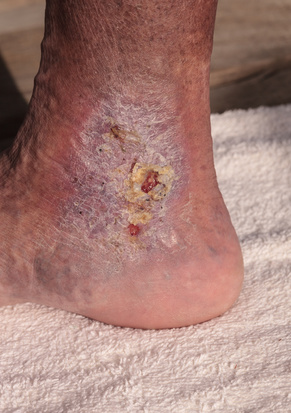Cellulitis Infection
Visit this
PICTURES OF RASHES PAGE
A cellulitis infection of the skin is a deep skin infection caused primarily by the staph or strep bacteria. Proper treatment of a cellulitis skin rash is critical. Otherwise, the skin infection may lead to serious health complications and even death.
Cellulitis Cause
The cellulitis is caused by the staph bacteria entering the skin structure. This can occur through cuts, scraps, or any injury that breaks the skin’s protective surface. Certain skin conditions such as eczema or psoriasis may also lead to cellulitis if contamination of the affected skin area occurs. Animal bites, insect stings, or bug bites can lead to the development of the cellulitis skin infection as well. It is very important to always keep broken skin areas clean.
However, it is not always necessary for the skin to be broken for an individual to develop the cellulitis infection rash. Any injuries that involve inflammation or fluid build up under the skin or conditions such as poor circulation can lead to this skin infection as well.
Symptoms of Cellulitis Staph Infection

The symptoms of a cellulitis staph infection include skin that is red, swollen, and warm to the touch. The infected area is usually very tender and painful. Blistering or an abscess may be present which drain pus or yellow fluid. Although the symptoms may be evident in only a small skin area at first, the cellulitis staph infection will spread and cover larger areas of skin if left untreated.
The lymph nodes in the vicinity of the skin infection are usually enlarged and tender. Characteristic red lines or red streaks known as lymphangitis appear when the cellulitis skin infection is present. These lines (or sometimes there is only one line) run from the cellulitis skin rash to lymph nodes. The lines are the path choosen by the body to drain the infection. If the cellulitis skin infection spreads to the blood, then the affected person will likely develop a fever.
The lack of warm skin in the affected area may be an indication that the skin problem is not a skin infection but rather some other type of skin rash. If in doubt, always consult a medical professional.
Cellulitis can occur anywhere on the body, but more likely on the arms, legs, and face. It is not a skin rash that is contagious.
Cellulitis Infection Treatment
Treatment of the cellulitis rash involves prescription oral antibiotics for approximately a ten day period after proper diagnosis of the cellulitis by a physician. If the cellulitis staph infection is more advanced, then the use of intravenous antibiotics so that the medication goes directly into the bloodstream will be used and a hospital stay may be necessary. Sometimes the patient will have a portable intravenous unit attached to the skin, which administers the antibiotic at set times for several days to treat the cellulitis infection.
